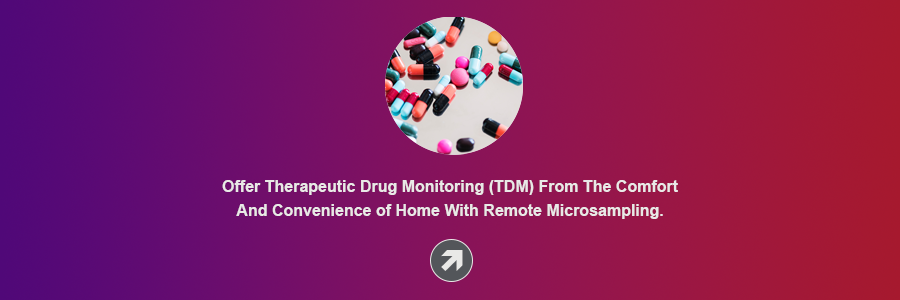Share this
the future of patient monitoring: what's now, what's next
by Neoteryx Microsampling on Jan 30, 2019 5:03:00 AM
 In the field of medicine, remote patient monitoring, also known as telemedicine, is one of the most interesting stories of the 21st century. It involves the use of high-tech gadgets to keep track of patients’ health progress and send information to doctors. This simplifies the patient monitoring process and sometimes allows patients to receive full care in remote locations, or even without leaving home.
In the field of medicine, remote patient monitoring, also known as telemedicine, is one of the most interesting stories of the 21st century. It involves the use of high-tech gadgets to keep track of patients’ health progress and send information to doctors. This simplifies the patient monitoring process and sometimes allows patients to receive full care in remote locations, or even without leaving home.
What Is the Future of Remote Patient Monitoring?
This technology has the potential to reduce the inconvenience of stringent medication regimens and can be part of creating safer and more standardized processes. This shifts the focus of practitioners and professionals to patient care, since they have more time.
It also helps in improving the efficiency of healthcare and eventually reducing costs. It promises an increase in the accessibility and improves the value of care for both the patients and the care providers.
With this technology, it is easy to reach under-serviced communities. The combination of this technology and other technologies, such as improving the speed of internet connectivity will play a big role in boosting smarter healthcare. Other than providing smarter healthcare, this technology is also going to prove useful in educating health practitioners.
It will be easier for people living in inaccessible areas to access healthcare. This is because the high-tech devices have the ability to break geographic barriers. This greatly improves the diagnosis and management of chronic conditions.
Remote patient monitoring will aid in research. For instance, in a study conducted in Italy to evaluate compliance of patients with the required standards, the researchers had a challenge due to lack of accurate data on patients with the chronic diseases from the administrative database. This is because the administrative database does not record the diagnosis for outpatient patients.
Challenges in Remote Patient Monitoring
As RPM catches on, medical cybersecurity is of paramount importance. Patient information must be protected using the best methods available, steadily updated.
One of the challenges facing this technology is the difficulty of convincing patients to use digital apps. Some patients are not willing to pay for the apps, which can be discouraging for app developers and risk-taking leaders in the field.
Nonetheless, remote patient monitoring has seen great progress since innovation and continues to develop. What challenges there are can be overcome by applying our best thinking and our best new innovations, such as blood microsampling technology, a key element in patient monitoring.

Share this
- Microsampling (206)
- Research, Remote Research (119)
- Venipuncture Alternative (105)
- Clinical Trials, Clinical Research (83)
- Mitra® Device (73)
- Therapeutic Drug Monitoring, TDM (51)
- Dried Blood Spot, DBS (39)
- Biomonitoring, Health, Wellness (30)
- Infectious Disease, Vaccines, COVID-19 (24)
- Blood Microsampling, Serology (23)
- Omics, Multi-Omics (21)
- Decentralized Clinical Trial (DCT) (20)
- Specimen Collection (18)
- Toxicology, Doping, Drug/Alcohol Monitoring, PEth (17)
- Skin Microsampling, Microbiopsy (14)
- hemaPEN® Device (13)
- Preclinical Research, Animal Studies (12)
- Pharmaceuticals, Drug Development (9)
- Harpera Device (7)
- Industry News, Microsampling News (5)
- Antibodies, MAbs (3)
- Company Press Release, Product Press Release (3)
- Environmental Toxins, Exposures (1)
- July 2025 (1)
- May 2025 (1)
- April 2025 (2)
- December 2024 (2)
- November 2024 (1)
- October 2024 (3)
- September 2024 (1)
- June 2024 (1)
- May 2024 (1)
- April 2024 (4)
- March 2024 (1)
- February 2024 (2)
- January 2024 (4)
- December 2023 (3)
- November 2023 (3)
- October 2023 (3)
- September 2023 (3)
- July 2023 (3)
- June 2023 (2)
- April 2023 (2)
- March 2023 (2)
- February 2023 (2)
- January 2023 (3)
- December 2022 (2)
- November 2022 (3)
- October 2022 (4)
- September 2022 (3)
- August 2022 (5)
- July 2022 (2)
- June 2022 (2)
- May 2022 (4)
- April 2022 (3)
- March 2022 (3)
- February 2022 (4)
- January 2022 (5)
- December 2021 (3)
- November 2021 (5)
- October 2021 (3)
- September 2021 (3)
- August 2021 (4)
- July 2021 (4)
- June 2021 (4)
- May 2021 (4)
- April 2021 (3)
- March 2021 (5)
- February 2021 (4)
- January 2021 (4)
- December 2020 (3)
- November 2020 (5)
- October 2020 (4)
- September 2020 (3)
- August 2020 (3)
- July 2020 (6)
- June 2020 (4)
- May 2020 (4)
- April 2020 (3)
- March 2020 (6)
- February 2020 (3)
- January 2020 (4)
- December 2019 (5)
- November 2019 (4)
- October 2019 (2)
- September 2019 (4)
- August 2019 (4)
- July 2019 (3)
- June 2019 (7)
- May 2019 (6)
- April 2019 (5)
- March 2019 (6)
- February 2019 (5)
- January 2019 (8)
- December 2018 (3)
- November 2018 (4)
- October 2018 (7)
- September 2018 (6)
- August 2018 (5)
- July 2018 (8)
- June 2018 (6)
- May 2018 (5)
- April 2018 (6)
- March 2018 (4)
- February 2018 (6)
- January 2018 (4)
- December 2017 (2)
- November 2017 (3)
- October 2017 (2)
- September 2017 (4)
- August 2017 (2)
- July 2017 (4)
- June 2017 (5)
- May 2017 (6)
- April 2017 (6)
- March 2017 (5)
- February 2017 (4)
- January 2017 (1)
- July 2016 (3)
- May 2016 (1)
- April 2016 (2)


No Comments Yet
Let us know what you think